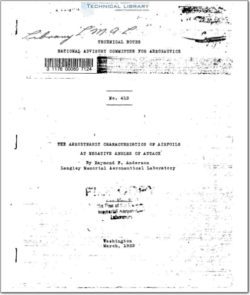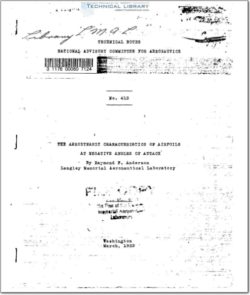naca-tn-412

- Version
- 217 Downloads
- 1.73 MB File Size
- 1 File Count
- April 23, 2016 Create Date
- April 23, 2016 Last Updated
National Advisory Committee for Aeronautics, Technical Notes - The Aerodynamic Characteristics of Airfoils at Negative Angels of Attack

There is at present litt-le information on the aero-
dynamic characteristics of airfoils at negative angles of
attack. In' the few_ tests which have been made the Rey—
nolds Number has been low.
The need for additional data in this range was re—
cently experienced by the Bureau of Aeronautics. Navy De—
partment, While th-ey were formulating rational procedures
to be folloWed in designing- airplanes for the divo and in-
verted flight conditions. Accordingly, a number of air—
foils suggested by'the'Bureau of Aeronautics and a number
of N.A.C.A. airfoils were tested at negative angles of at-
tack in the N.A.C.A.'variableedensity~wind tunnel at a
Reynolds Number of approximately 3,000,000.
Part of the results were published in a preliminary
note (reference 1) befor-e the tests were completed. The
present report_ gives all the _results, including those pub—
lished in r.eference l and the results of previously un-
published tests of the airfoils at pOsitive angles of at—
tack.
A brief description of the redesigned variable~den~
sity wind tunnel and its method.of operation_will be found
in reference 2. The customary 5 by 30 inch polished du—
ralumin airfoils were used in the tests. In reference 2
will be found a deseription of the method of constructing
the'airfoils. The specified ordinates will be found in
Table I.
The airfoils were tested.in the usual'manner (as de—
scribed in reference 2) except for the method of mounting
on the support struts. When airfoils are tested at posi—
tive angles of attack they are mounted on the support
struts of the balance with the sting and struts attached
on the flat side. For these tests, however, the airfoils
were inverted and the sting was placed on the curved sur—
face to leave the flat surface free from obstructions that
might affect the Value of the maximum negative lift coef—
ficient.
| File | Action |
|---|---|
| naca-tn-412 The Aerodynamic Characteristics of Airfoils at Negative Angles of Attack.pdf | Download |

Comment On This Post